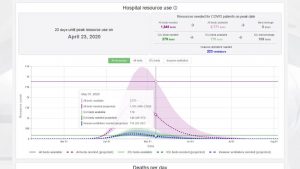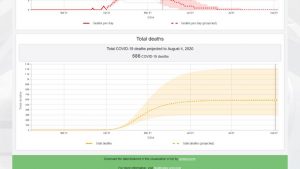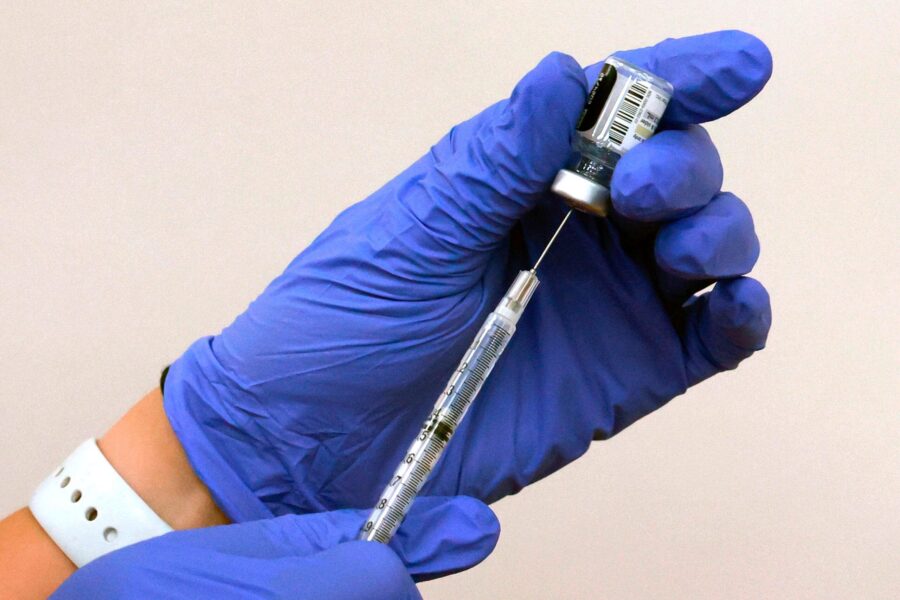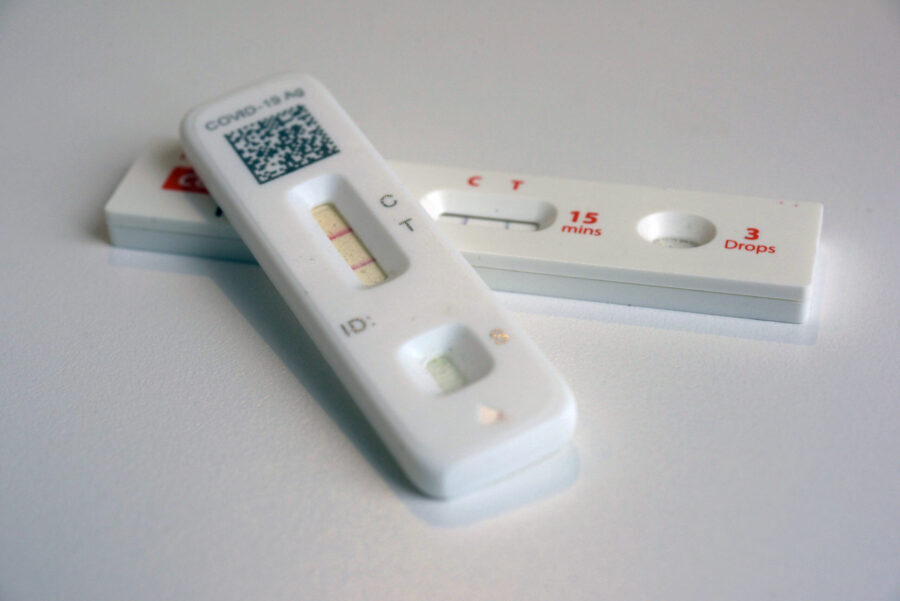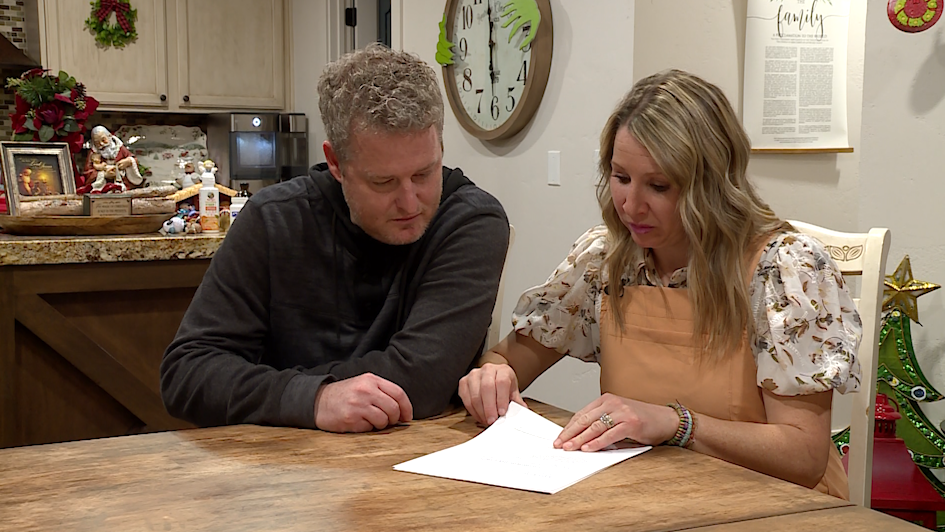Model Cited By White House Shows Potential Number Of COVID-19 Deaths By August
Apr 1, 2020, 7:25 PM | Updated: Jul 1, 2022, 11:28 pm
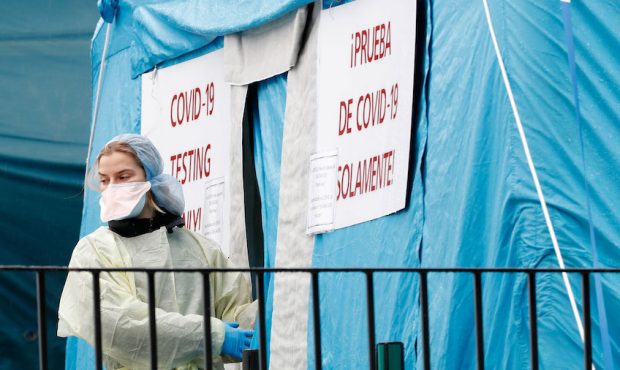
A medical worker prepares to reenter a COVID-19 testing tent set up outside Elmhurst Hospital Center in New York, Saturday, March 28, 2020. The hospital is caring for a high number of coronavirus patients in the city, and New York leads the nation in the number of cases, according to Johns Hopkins University, which is keeping a running tally. (AP Photo/Kathy Willens)
(AP Photo/Kathy Willens)
(CNN) — President Donald Trump’s decision to extend social distancing guidelines until April 30 came after officials reviewed 12 different statistical models, said Dr. Deborah Birx, the White House coronavirus response coordinator, during a Sunday press briefing.
But standing in the Rose Garden, Birx also mentioned another model, created independently, that “ended up at the same numbers.” That analysis, which is publicly available, paints a grim picture of what’s to come in the U.S., even with social distancing in place.
As of Monday morning, it estimates that more than 2,000 people could die each day in the United States in mid-April, when the virus is predicted to hit the country hardest. The model, which is updated regularly, predicts that 224,000 hospital beds — 61,000 more than we’ll have — will be needed on April 15, when the U.S. is estimated to reach “peak resource use.”
And assuming social distancing will continue through May, it finds that, by August, around 82,000 people in the U.S. could die from COVID-19.
Birx, pointing to the model on Sunday, said “you can see the concern that we had with the growing number of potential fatalities.”
The analysis relies on data from Italy, China and the United States, using past experiences to predict the future.
Like many models, the projections are imperfect, but the researchers behind the project still came to an unsettling conclusion: “Even with social distancing measures enacted and sustained, the peak demand for hospital services due to the COVID-19 pandemic is likely going to exceed capacity substantially.”
‘An Alarming Number’
Designed by the University of Washington’s Institute for Health Metrics and Evaluation, the model relies on information from state and national governments, hospital groups and the World Health Organization.
Birx, the White House health official, also mentioned the model to Chuck Todd on “Meet the Press” this weekend. “No state, no metro area will be spared,” she said during the interview.
State and local officials should quickly react to the coronavirus threat and enact social distancing measures, she said, so that “we’ll be able to move forward together and protect the most Americans.”
Deaths could be higher if states don’t enact those measures — or if people don’t follow them.
The model, for example, assumes that officials will limit social contact through May: closing schools, enacting stay-at-home measures, and limiting travel and non-essential business. For states that don’t implement at least three of the four measures, the model’s estimates for hospital usage and deaths will go up.
“Our estimate of 81 thousand deaths in the U.S. over the next 4 months is an alarming number,” the researchers wrote, “but this number could be substantially higher if excess demand for health system resources is not addressed and if social distancing policies are not vigorously implemented and enforced across all states.”
The nation’s top infectious disease specialist, Dr. Anthony Fauci, told CNN’s Jake Tapper on Sunday that substantially more people could die: “Looking at what we’re seeing now, I would say that 100,000 and 200,000” deaths could occur.
“But I don’t want to be held to that,” said Fauci, the director of the National Institute of Allergy and Infectious Diseases. He cautioned that modeling is imperfect, and said, “I just don’t think that we really need to make a projection when it’s such a moving target that you can so easily be wrong and mislead people.”
States Face Difference Challenges
In places already hard-hit by the virus, such as New York, that date is predicted to come sooner. The state will need around 71,574 hospital beds on April 9, leading to a shortage of more than 58,564 beds, according to the model. New York will also need about 8,855 ventilators.
The state’s governor, Andrew Cuomo, thinks the reality could be more dire.
He has called for 30,000 ventilators in the state, and on Saturday, he said New York will need about 140,000 beds at the virus’s apex, which he forecasted to be 14 to 21 days away. Perhaps driven by those predictions, the governor has worked aggressively to build hospital capacity.
On Monday, a 1,000-bed hospital is set to open in a New York convention center, and Gov. Cuomo said on Saturday that Trump had approved four new emergency medical facilities in the state, providing 4,000 additional beds. The USNS Comfort, a naval hospital, also arrived this week, bringing 1,000 beds, which will be used for patients who don’t have COVID-19.
Other states are expected to need far fewer beds, according to the model. Florida, for example, won’t hit “peak resource use” until May 3. And while the state is projected to need almost 17,000 hospital beds at that time, it will have at least 20,000 available. More than 6,000 people there, however, are still predicted to die by August.
Florida’s governor, Ron DeSantis, has worked to limit community spread in the state, focusing his ire on New Yorkers and setting up checkpoints for travelers from the state. “The point is we need those folks coming in to self-isolate for 14 days,” DeSantis said on Saturday.
For weeks, though, DeSantis resisted calls to take aggressive action in Florida — refusing to close the state’s beaches, and choosing instead to limit gatherings there to 10 people.
Dr. Scott Gottlieb, the former commissioner of the U.S. Food and Drug Administration, said in a Sunday tweet that “Florida is at risk of becoming major epicenter of epidemic spread of #COVID19 in the coming weeks.”
He added that “Miami appears to be a major hot spot. The outbreaks were apparent there weeks ago. And the state was slow to implement mitigation steps, and probably exported a lot of its infection.”
As more information becomes available, the IHME coronavirus model could change, and outlooks for states could worsen if mandated social distancing is not enacted and followed.
“Uncertainty in the time course of the epidemic, its duration, and the peak of utilization and deaths is large this early in the epidemic,” wrote the researchers who created the model. “Given this, it is critical to update these projections as new data on deaths in the US are collected.”
As of now, though, the model predicts that another large state, California, will face no shortage of intensive care beds at its peak. But Louisiana, a far smaller state, will need 700 more than it has.
The southern state is a budding coronavirus epicenter, having seen more than 180 deaths so far. California, which has 35 million more residents, has reported about 120 deaths.
While Louisiana is expected to be hit hardest on April 10, the model predicts that California’s peak will come about two weeks later, giving the state more time to prepare for a surge in cases.
Birx, the White House official, acknowledged last week that timelines would differ around the country, saying that “each state and each hotspot in the United States is going to be its own curve, because the seeds came in at different times.”
Virus Effects On Utah
Utah epidemiologist, Dr. Angela Dunn, said the state will most likely reach peak daily deaths beginning April 22, with 586 people projected to die from the virus by August.
“I hope we don’t reach that number, but we are preparing for those situations,” Dunn said about state death projections.
“I hope we don’t reach that number but we are preparing for those situations," says @DrAngelaCDunn about #Utah #COVIDー19 death projections.
New modeling from @IHME_UW says Utah will reach peak hospital strain on April 23 and will be short 109 #ICU beds. @KSL5TV @kslnewsradio pic.twitter.com/k1Eo2BnV6W
— Ladd Egan (@laddegan) April 2, 2020
Dunn also said Utah will reach peak hospital strain by April 23, according to data from the Institute for Health Metrics and Evaluation.
Models Are Imperfect, Researchers Say
The researchers behind the model caution that its predictions are imperfect.
They’re based in part on information from the U.S. and Italy, but the model also uses data from Wuhan, China, where officials aggressively implemented four social distancing measures: closing schools, shuttering non-essential businesses, ordering residents to shelter-in-place and restricting travel.
Researchers assumed that just three of those measures — not all four — would be enough in the U.S. to follow a trajectory similar to Wuhan. But “it is plausible that it requires all 4 measures,” wrote the researchers in a paper accompanying the data.
In the US, for example, states have yet to order legally binding travel bans. But many regions have closed schools, ordered businesses closed and told people to stay inside.
There are countries and places “who have done a little bit more than these three measurements,” said Ali Mokdad, a professor of health metrics sciences at Washington’s Institute for Health Metrics and Evaluation.
“They have shut down airports and they have cancelled travel in and out of the country,” said Mokdad, who worked on the model.
Many restrictions in the U.S. have been voluntary, too, without the aggressive enforcement seen in China. The researchers wrote that “it will take time to evaluate whether social distancing adherence is fundamentally different in the U.S. compared to Wuhan.”
The model does take into account some differences between countries — such as how old a population is — but it doesn’t consider other factors that could impact how many people die during an epidemic. The prevalence of chronic lung disease, for example, could affect mortality rates.
The analysis predicts specific numbers, such as 82,000 deaths in the U.S. through August, but it also provides a range of possibilities. It estimates that total deaths in the U.S. as of August could be as low as 39,000 for example, or as high as 141,000.
Fauci, the infectious disease specialist, said on Sunday that “when someone creates a model, they put in various assumptions, and the model is only as good and as accurate as your assumptions.”
Those models “give a worst case scenario and a best case scenario,” he said. “Generally, the reality is somewhere in the middle.”
Things Can Still Change, Researchers Say
One thing does seem certain: As demand for medical care skyrockets, hospitals have faced — and will continue to face — difficult choices. In New York, for example, one hospital system banned all visitors including partners during childbirth, before being overruled by the governor.
In Queens, a health care worker told CNN that there was an “every man for themselves” mentality when it came to protective equipment in the hospital.
And a letter from one Michigan hospital system — drafted for a potential worst-case scenario — described how care could be rationed: “Patients who have the best chance of getting better are our first priority.”
But things could still improve, especially in states that are still weeks away from their peaks.
Canceling elective procedures and encouraging people to only seek necessary care could free up hospitals, researchers said. Repurposing unused space — such as operating rooms, staff quarters and hallways — could temporarily increase bed capacity. And hospitals could bring on additional staff by increasing overtime, rehiring workers and using volunteers.
In New York, the nation’s coronavirus epicenter, about 1,000 people have already died after being infected. But Cuomo on Friday announced that more than 60,000 medical professionals — including retired practitioners — have already offered to volunteer their services. As many as 10,000 people signed up on one day last week.
Mokdad, the professor who worked on the model, underscored the importance of that spirit, in the United States and around the world. “This pandemic has shown clearly for all of us that we need to work together,” he said.
“There’s nothing positive about this virus destroying people and economies,” said Mokdad. “But I hope that we work together as countries from now on, instead of saying it’s China, it’s Iran, and so on. Otherwise, it will impact all of us. This is a lesson for all of us to come together and save lives.”
KSL TV’s Ladd Egan contributed to this report.


